Re-Villaging Our Communities — Starting With Love Thy Neighbor, Chapter 9 Part 1
Connecting the Good on the Street Where You Live
Welcome to the Birthing the Symbiotic Age Book!
NEW here? — please visit the TABLE OF CONTENTS FIRST and catch up!
You are in Chapter 9, Part 1— Re-Villaging Our Communities — Starting With Love Thy Neighbor: Introduction… Connecting Neighbors in “Garage Door Neighborhoods”… How Get-To-Know-Your-Neighbor Week Transformed a Region… Nexus Agency and the “Community Ark” Movement
Chapter 9 posts:
Are you trying to figure out where this is All Going? Read an overview of the Symbiotic Culture Strategy, which embodies the Transcendent through the nodes of intersection within local, grassroots-empowered community networks.
Voice-overs are now at the top of my posts for anyone who doesn’t have the time to sit and read! Also, find this chapter post and all previous posts as podcast episodes on
Spotify and Apple!
Previously, at the end of Chapter 8, Part 4
As we will see as we explore the other networks that we developed in Reno, these emanated from an “organized and unified” community ground of being that extended the Ancient Blueprint first one-on-one, then to small circles of trust, then to a larger group of like-minded collaborators, and finally to a larger distributed network.
Every phase recreated the fractal of loving Virtues.
That’s how we reached and impacted all of Northern Nevada, how Sarvodaya created its network of village economies, and how anyone reading this book and motivated to do so can become the seed wherever they are.
We began this chapter with the question, what will unite humanity?
I believe we have an answer—we are united by our common need to survive and thrive and our common longing, even if only dimly recognized, for Beloved Community. As our Reno group clarified our purpose, uncovered the principles, and identified our Virtues, we came up with the foundation of a new but age-old story—Symbiotic Culture.
We now have an Ancient Blueprint to guide us—to spread the DNA of this culture fractally. If we choose to accept it, we also have a mission—each of us—to proliferate intentional mutual benefit and be a channel for Cosmic Love. We co-create that Kingdom of Kindness, that Culture of Connection, by living it now in whatever communities
or situations we find ourselves in.
Introduction
Our unique experiment in symbiotic community and crowd-sourced wisdom had accomplished much in four years, building ecosystem networks that aggregated the positive energy of previously siloed nonprofit, business, and local governmental organizations and everyday local citizens. In creating these networks, we discovered the Symbiotic Culture DNA and a step-by-step “cultural change” process for “fractally” implanting the Ancient Blueprint in every one of our endeavors – that then spread through the networks we were already embedded in.
We did this without creating a new, separate, formal organization with its budgets, staff, and funding needs — in its separate silo.
Instead, we did something radically different — we created a network-centric structure, more like an organism, that functioned as scaffolding for a new culture and society, where participating people and organizations collaborating for mutual benefit became our new local operating system.
We had created two active symbiotic networks — essentially “parallel societies” — with the potential to emerge into regional and even global networks.
Just as Gandhi and Dr. Ari envisioned a network of village economies, we saw how these local networks could scale into a global commonwealth of strong regional economies.
We had a thriving, organically evolving network supporting local businesses, organizations, and locally grown food. We gathered wisdom from many sources to identify our shared principles, cherished Virtues, and community needs. We built gentle network structures to create a sense of purpose and coherence and “connected the good” already happening into a power for change.
Taking a cue from Sarvodaya, we identified the twelve critical needs in our community and looked to use our common purpose, practical principles, and “universal Virtues” to address these needs. In a more diverse and sophisticated community than Sri Lanka, we shared and operated from a unifying worldview that included and transcended spiritual, religious, and secular ethical traditions.
Yes, we had identified fragmentation and disunity as the common problem and defined our guiding principles. Now, the challenge was, how do we embody and ground these principles into an ongoing practice of what would become a Network Commons that could lead to new regional economic and governance structures parallel to and yet not opposing the “official” ones?
How could we make Martin Luther King’s vision of an “inescapable network of mutuality” more tangible in our community? Along those same lines, how could we infuse human-scale “village virtues” into our motorized, mechanized, and impersonal urban-suburban culture?
We had so many good ideas emerge from that community gathering on Valentine’s Day.
What would be next?
In the year following our meeting, one idea percolated up from the wellspring of community caring and potential. It had to do with the literal application of the Ancient Blueprint of “Love God and Love Thy Neighbor.” While the buy local and food networks addressed the economic foundation of a symbiotic community, we also recognized a broader spiritual need, particularly in light of the fragmentation, separation, and isolation we had observed.
Our Valentine’s Day meeting and the crowdsourcing of a common purpose, principles, Virtues, and needs gave us a solid “ground of being” from which to work.
The next step seemed to be applying the principles and Virtues to more specifically address our community's deeper, invisible needs to take “love thy neighbor” and “charity begins at home” from community principles to real-world community practices.
We also realized something else. Just as Sarvodaya inexorably related the Transcendent and the immanent, bringing "Heaven” to Earth, we needed to engage more citizenry to begin practicing the principles and Virtues of symbiotic culture and community.
We had identified a “neighbor-to-neighbor” connection as one of the twelve common needs, and now the question was, how do we address this need?
Connecting Neighbors in “Garage Door Neighborhoods”
Just as modernization had led to big box stores nudging out mom-and-pop businesses, many neighborhoods had transitioned from front porch to backyard, or as we called these new suburban enclaves, “garage door neighborhoods.” That is, once people disappeared into their homes, the only revelation about who they were and what they enjoyed was a peek into their open garage doors.
A popular book that influenced us then was Robert D. Putnam’s Bowling Alone. Published in 2000, the book describes “social isolation” in the wake of a suburbanized society, where it’s difficult for people to meet randomly and spontaneously and where everyone is busier and busier, less likely to interact face-to-face. Two decades before COVID, we had already begun the practice — largely unconsciously — of “social distancing.”
In June 2007, I wrote an opinion piece for the Reno Gazette-Journal, the city daily newspaper, pointing out that we have the wherewithal to travel globally in our modern world. Yet, we may not take the time to get to know our neighbors down the street. I was reminded of an essay by Dr. Bob Moorehead, former pastor of Seattle’s Overlake Christian Church, offering a quote attributed to both George Carlin and the Dalai Lama, “The Paradox of Our Age”:
“We’ve been all the way to the moon and back but have trouble
crossing the street to meet our neighbor.”
Within two weeks, it became clear that my opinion piece clearly had struck a nerve, as many spontaneous, simultaneous gatherings emerged throughout the region. We realized that “neighbor-to-neighbor” was as much of a building block of the community as local food, local economy, and local arts and culture.
Once again, during that next year, I reached out to connectors and super-connectors to help make real that ideal of “love thy neighbor.” We used the same organic process of bringing together what would become a symbiotic region-wide neighbor-to-neighbor network. This is another example of how Symbiotic Culture DNA fuels “fractal community empowerment” – how good ideas can emerge simultaneously and spontaneously without the need for formal, organized structures.
We began with the same one-on-one process to get the first level of “buy-in” from existing community organizations, businesses, and local government. In addition to those already involved in our Conscious Community Network, I contacted people who were part of the neighborhood advisory boards, community advisory boards of the City of Reno and from across Washoe County, and even neighborhood watch groups.
If the private online social network Next Door had existed, we would have also used that platform. Once again, I identified the connectors and super-connectors county-wide and in specific neighborhoods. Without any top-down planning or formal organizational structures, we began to meet to discuss ways to bring neighbors and neighborhoods together.
Like the networks that preceded them, these neighbor-to-neighbor networks were
self-organizing, fractal, and “emergent.”
Those in each neighborhood who “felt the call” began where they were with a minimum of “friction” to start.
In some neighborhoods, organized activities and events were already ongoing, while others had no preexisting infrastructure.
Neighbor-to-neighbor catalytic connectors began to spontaneously organize block parties and potluck events at their own homes, apartment and condo complexes, streets, and cul-de-sacs. When we had enough of these leaders, we got together, compared notes, and later created a Neighbor-to-Neighbor manual so that anyone in any neighborhood could initiate a gathering.
Hearkening back to my San Diego days, I decided to start in my own neighborhood and begin with gatherings at my own home. Success wasn’t “instant,” but it built over time. I reached twenty homes in the first year, and four people showed up. The following year, we had ten people, and the third year, we had a full house. That’s why we use the term “building a symbiotic culture” … it doesn’t spring up fully manifested instantly but builds momentum over time.
Being a neighbor connector, particularly for those who are not naturally extroverted, requires courage. I remember reading somewhere that one of humans' biggest fears is getting up in front of a room to speak. How about knocking on a neighbor's door you haven’t yet met?
It’s normal for most of us to experience apprehension and hesitance initiating a connection like this. And this is part of the process when you commit to building a symbiotic culture — being comfortable stepping into your “discomfort zone.”
So, the best place to start is where you are — the street where you live. If there’s anything that will make this outreach easier, it’s connecting in advance with the Transcendent, particularly the Virtues.
When we remember our purpose to “bring the Cosmos together in love” and recognize each of these Virtues as a portal for radiating that love, we can become more confident about the encounter because we’re reminding ourselves why we are doing it — as a way of expressing kindness, generosity of spirit, caring, compassion, and goodwill.
Love thy Neighbor is not just a feel-good metaphor but the literal power each of us has to bring Heaven to Earth — where you are right now.
In retrospect, it is evident to me that our networks thrived and spread because of our foundational purpose to connect the good and proliferate intentional mutual benefit. So many social change endeavors focus on external “fix-it” schemes that operate primarily on the “material” level. However, it’s the simple and singular purpose at the bottom that gives a project depth and staying power, especially when challenges arise.
Our foundation built on the Ancient Blueprint was a constant reminder to put “self-giving” ahead of self-serving. When we focus on what we will be giving as we reach out –in contrast with how little we are asking -- we see ourselves as ambassadors rather than intruders.
Remember that while it may seem that reaching out to neighbors who are strangers is an “external” act, the context is internal. It requires each of us to connect more deeply with whatever we recognize as the core of our being -- a power greater than ourselves, what we have called the Transcendent.
Think of it as expressing your desire to contribute to the highest good. When you are aligned with the purpose of building a Culture of Connection and embodying the Virtues, you are literally “injecting” those Virtues into your neighborhood! Think of this transmitting Symbiotic Culture DNA as spreading a “healthy heart/mind virus” that activates the inner resources of everyone involved – often “silently” and without fanfare.
Again, without officially “codifying” it, we followed the fractal empowerment formula by radiating outward from where we are and building trusted networks along the way.
In reaching out to my neighbors, I used the same tried-and-true strategy we pioneered for the Conscious Community and food networks. I connected with neighbors and invited them to reach out to other neighbors. The strategy was to identify and connect with neighbors they knew, form a team of those most interested, and develop a simple flyer announcing the first neighbor event with the date, time, and other instructions.
Depending on how much cohesion already existed in the neighborhood, people would begin with a core group that had already worked together, or one individual would reach out to the people they wanted to include. These clusters would form in each community, and a neighborhood “caring committee” usually consisted of about a twenty-to-thirty-home radius around their home.
How Get-To-Know-Your-Neighbor Week Transformed a Region
Our neighbor-to-neighbor initiative must have spoken to the community’s unspoken needs because the local media immediately picked up on it, and the idea took on a life of its own. The weekly Reno News and Review and the daily Reno Gazette-Journal, who usually competed for market share, ran articles promoting what would become “Get to Know Your Neighbor” week. The TV and radio stations not only donated PSA spots but helped us write them.
Our cable network donated 4,000 30-second TV spots throughout Northern Nevada. The newspapers featured our lighthouse logo for two weeks and wrote daily stories about us. In fact, they made themselves our partners, which created a high level of visibility and legitimacy. It’s good to be “adopted”!
The newspapers published our flyers that had messages like these:
“5th Annual Get to Know Your Neighbor Week:
Make a Difference Right Where You Live.
Do your own gathering by hosting a potluck meal and invite your neighbors, have a BBQ at your home, or do a block party. Or, say hi to your neighbors.”
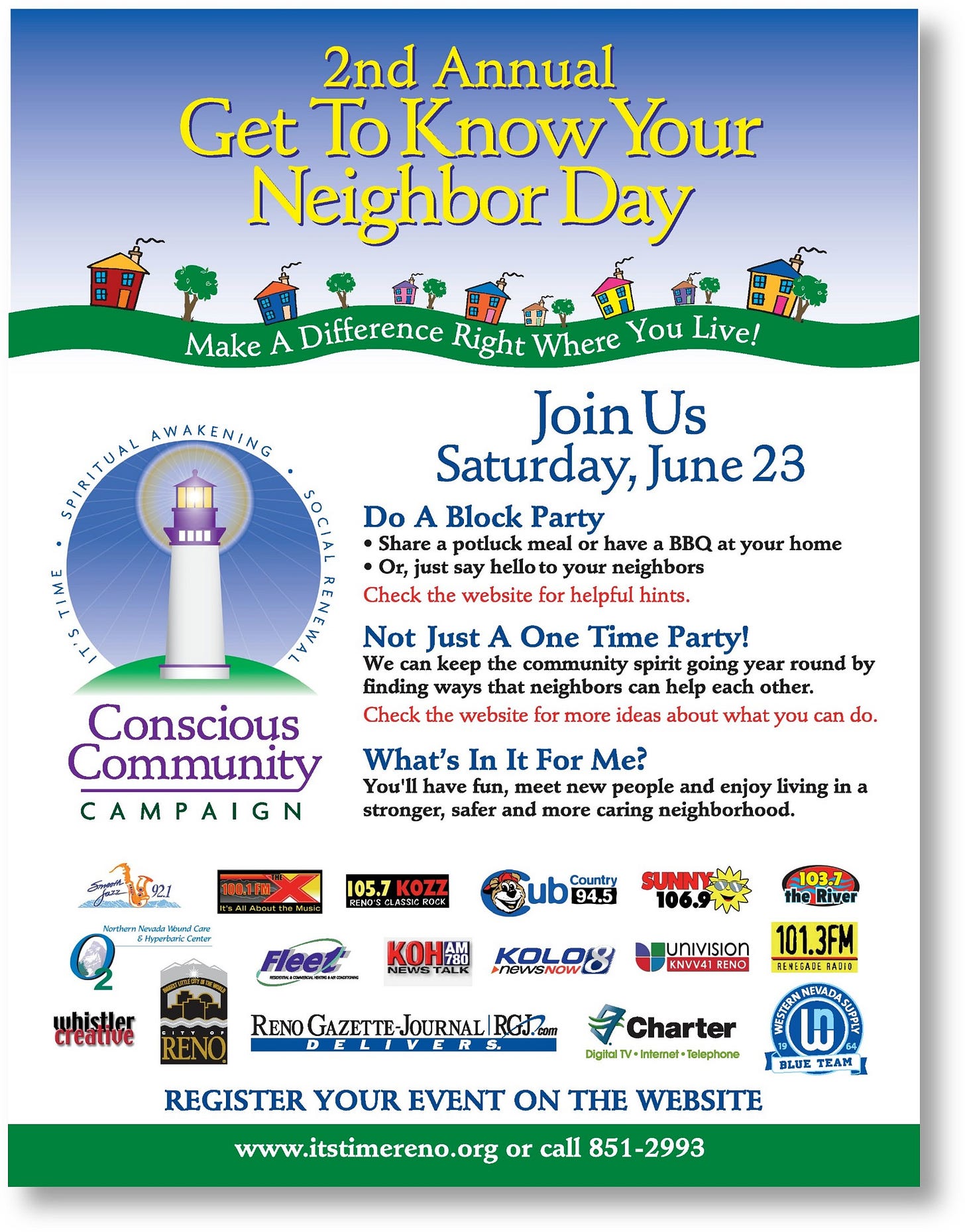
The campaign included a website where people could go for helpful hints. The message also made it clear that it wasn’t just a “one-off” and encouraged neighbors to form what we called, at the time, neighborhood “caring circles.” We encouraged people to see what was in it for them. We told folks they would have fun, meet new people, and help create a stronger, safer, and more caring neighborhood.
The campaign quickly spread from Reno proper to the surrounding Northern Nevada region. Here is an article excerpt from the local Sparks (NV) Tribune:
“More than 65 different gatherings were registered with the Conscious Community Network, and Richard Flyer estimated there could have been another 30 to 40 events…being a good neighbor isn’t a one-day thing – “it’s a lifestyle,” Flyer said.
Flyer also indicated, “It’s more than a one-time party, but really an effort to connect a disconnected culture; so many people continue to help their neighbors after the event… he continued, “If we want peace in the world, let’s build the foundation for it in our hearts, our families, and right on the streets where we live,” he later said in an interview. “That foundation is, ‘Love your neighbor.’”
Since I was a visible part of the neighbor project, I became a public figure in this region of 400,000 people. Over the next few years, we grew to perhaps a hundred gatherings simultaneously, with thousands participating. We nearly made it into the Guinness Book of World Records, and for the fourth annual “Get to Know Your Neighbor Week,” Parade magazine, with a circulation of 40 million, did a story.
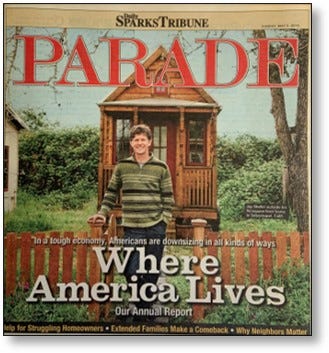
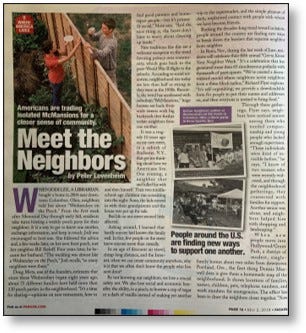
The Parade piece quoted me as saying, “We’ve created a decentralized model where neighbors invite neighbors from a three-block radius. It’s self-organizing. We provide a downloadable form for people to put their names and addresses on, and everyone is invited to bring food.”
The Parade article picked up on something else that emerged over four years: those in the neighborhoods who had fallen between the cracks and were now visible — older people who needed companionship and young people who needed guidance and mentoring.
The article again quoted me, “These individuals were invisible before. I know of two women who were recently widowed, and through the neighborhood gatherings, they connected with families for support. Another senior was alone, and neighbors helped him with shopping and landscaping.”
At the 2006 Valentine’s Day meeting that sparked collaboration to bring forth our collective Virtues and principles and upgrade our purpose, we intended to “take our love higher.” In the practical application that became our neighbor-to-neighbor movement, we took it broader and deeper.
Indeed, what we did for the “least of us” brought out the best in us.
We discovered unmet needs and brought underserved individuals into our symbiotic community. We did this not in the context of a “charity” or as part of any number of “social justice” causes or ideological agendas, even ones like regenerative communities, but instead simply being of service to people out of pure Love, as community members, as “equals” who may have fallen into circumstances where they were temporarily less than equal.
Our Neighbor-to-Neighbor movement was far more than a “one-time party.” It was a new way of living, where we could “flatten” hierarchies and draw all neighbors into our circle beyond political or religious differences or separating views. We were consciously nurturing – and living – a Culture of Connection in the most practical way possible.
In retrospect, I see this as quite an evolution from my “social change” work in the 1980s as part of the anti-nuclear movement, where I honestly believed that community work was about finding and activating those who thought the same way as I did about the issues of the day. I fervently believed my work was to convert others to my point of view, and most of what we would now call political or social activism still operates under the same principle. Well intended as this activism might be, it is still reinforcing the Culture of Separation, still on the battlefield.
In contrast, imagine a network where the primary focus is making “love thy neighbor” real. Under this broad and universal principle, solutions to problems emerge as part of the community’s collective will rather than from some system of ideas.
Can you imagine how it would be to live without promoting an agenda –
other than Love itself?
Over the years, as I have shared the practice and way of life of getting to know your neighbor, people commonly ask, “Why would I want to connect with my neighbors who don’t share my beliefs?”
My answer is it’s not about you or your personal likes or dislikes – it’s about practicing Love thy neighbor as a way of being, extending mutual benefit above and beyond the silos of whatever “worldly” identity we identify with. It’s remembering that every one of the “good causes” we align around is a fractal of an even higher purpose, “bringing the Cosmos together in love.”
So, what did this practice of “Love thy neighbor” look like in day-to-day reality?
As our connectors, super-connectors, and helpful neighbors went door-to-door, they met real people, sometimes in difficult external circumstances, sometimes suffering from loneliness and isolation. In a sense, these people were themselves “untapped resources.”
By bringing these individuals out of isolation and into the larger community, their gifts and experiences became assets for the whole community.
We served not as do-gooders from outside with a plan and program but as curious, compassionate neighbors addressing immediate needs.
For example, you might notice an older or disabled individual unable to care for their lawn and connect them with a local teen on the same street looking for a way to serve. In addition to formal charitable acts — like volunteering at a homeless shelter or soup kitchen — our informal network exemplified the principle “charity begins at home” quite literally.
Nexus Agency and the “Community Ark” Movement
Our neighbor network also exemplified the “nexus agency” we described in Chapter 8. Each community neighbor network acted independently, based on their neighborhood's identified needs and desires. We never told anyone what to do — we provided a coherent platform, made suggestions, and sparked the connection and collaboration.
Injected with the Symbiotic Culture DNA, each independent neighborhood group held the same purpose, operated by the same principles, and practiced the same Virtues, spreading this healthy virus through their communities – fractal community empowerment!
Some of these groups organized specific networked initiatives, such as building community gardens, sharing resources and food, forming emergency response networks, mutual aid efforts, and so on.
We named this loosely connected network of neighborhoods the “Community Ark” movement. Recognizing we were “all in the same boat” in these times of challenge and separation, we took the term “re-localization” and made it real — a grassroots movement connecting individuals, families, and their immediate physical neighbors.
As I write this nearly two decades later, I see how much more relevant this work is, given a world disrupted by wars and seventy years of globalization and centralization that have led to supply-chain issues and challenges to food production and distribution. I’ve been contacted by numerous people concerned about securing their local food supply and hoping Symbiotic Networks can make a difference. In response to this emerging need, I created a “Neighbors4Neighbors” organizing template and manual in the fall of 2022 that you’ll read more about in Chapter 12 and Section 3.
Given these challenges, people everywhere are “naturally” finding ways to grow and exchange more food — there are more backyard and community gardens, more gleaning of food crops, and distribution of food close to its expiration date — as we did many years ago through the food bank in San Diego.
At that time in Reno, we always had a bumper tomato crop at our home but couldn’t grow lettuce worth beans!
So, we traded. This natural exchange makes practical sense and is also a conscious, intentional, coherent activity that reinforces intentional mutual benefit and local autonomy. These local, informal exchanges, springing up spontaneously everywhere, will become more critical during natural disasters and greater food insecurity.
It’s better to collaborate with one’s neighbors to act in accord during challenging times than trying to survive in an atmosphere of fear and mistrust, where it’s neighbor against neighbor.
So even if a person isn’t motivated by the lofty “love thy neighbor” ideal, there are very practical reasons to “know thy neighbor.”
Consider the contemporary platform Next-door and how it could be used to announce local real-world meetings and face-to-face events. This is the right use of social media — using the internet to improve conditions in the “outer net.” I’m not suggesting creating a potluck on Zoom, where everyone watches each other eat on a screen. We still need to go door-to-door and meet face-to-face; social media is simply a tool to facilitate that and increase turnout.
As these exchanges increased in frequency and intensity, an exciting thing happened. These neighbor networks began springing up and proliferating on their own because they were addressing some essential unmet needs. At the “street level,” people have started naturally forming what we came to call “caring circles” to connect the good through matching “needs” and “offers.”
Symbiotic Culture DNA was spreading “organically”, and a model was unfolding for the fractal “re-villaging” of the world.
Find out how we continued to apply Fractal Community Empowerment to neighborhood networks NEXT in Chapter 9, Part 2, Re-Villaging Community: Start With Loving Your Neighbor … A Micro-Culture of Caring Circles to Connect the Good … The Ancient Blueprint in Action… “Re-Villaging” the World, One Street at a Time…
PREVIOUS POST
TABLE OF CONTENTS
NEXT POST






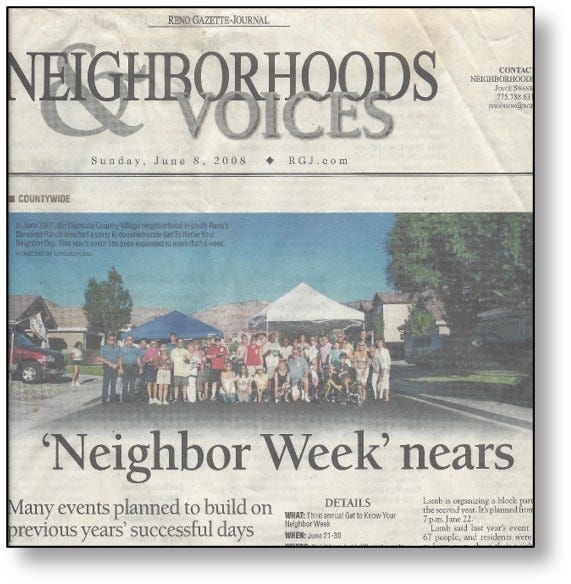
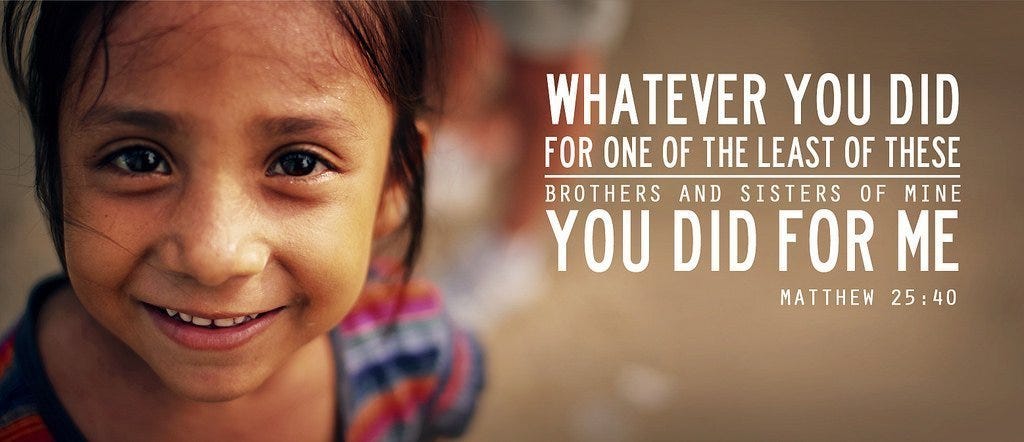

This reminds me of when I grew up in a village and we had the annual village feast. In some cases there are village shows or fêtes as they are called. Some are called Shows and are agricultural shows as well. My mother worked in one village that claims the largest show in England https://www.heckingtonshow.org.uk/
As for the food gatherings I used to co-ordinate Collective Kitchens. The idea is simple. You have a chef - and they tell others what to do. We tried to pick someone from a different culture each time - then they knew the tricks of their ethnic food - so an Italian did pizza for example. The chef then directs others to cook, we share the costs and the clean-up. SO everyone learns to cook better. If you cannot cook you still eat well. Over time we started to get a better range of food, more people and surprisingly donations e.g. a basket of apples. Also the cost was cheap - we were not making a profit and you have to cook anyway - we just shared the costs.
This collective kitchen was separate from the radical food projects like dumpster diving, soup Sundays or Restaurant Day - also started in Finland - where people had pop up restaurants in their own home. Though some of the same people were involved in these circles too. https://finland.fi/life-society/finlands-pop-up-carnival-of-good-taste/